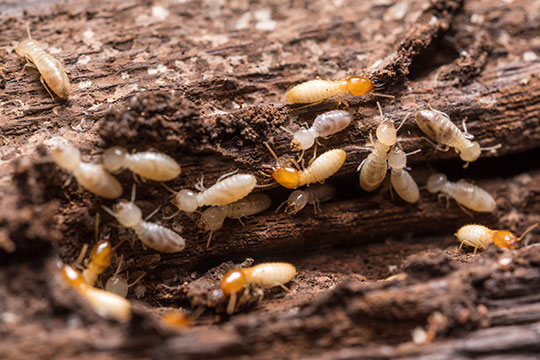Pest Profile
Insects![]()
Insects
TERMITES
Scientific name: Various
Termites are social insects that live and work together in nests found in soil or timber.
Members of the termite colony take different forms or ‘castes’, including:
- ALATES (meaning ‘winged ones’) – Alates are the true adult termites.
- REPRODUCTIVES – Reproductives are the sexual forms of the colony including future kings and queens of colonies yet to be established.
- SOLDIERS – Soldiers have darker, larger heads than the other castes. They are blind, wingless, and have undeveloped reproductive organs.
- WORKERS – Worker termites account for the largest number of termites within a colony, and are therefore responsible for the most damage.
Worker termites gather food, groom other termites, construct tunnels and repair damage in addition to tending to the kings, queens and their young. These termites are believed to work 24 hours a day throughout their 4-year life span. Worker termites are generally unpigmented. They are blind, wingless and have undeveloped reproductive organs.
In buildings, they often reside undetected, but as they are active non-stop day and night, they can cause serious damage to timber and wooden structures very quickly.
In nature, termites play an important ecological role by providing nesting holes for lizards, birds and possum. They also break down organic matter efficiently (and quickly), returning nutrients to soils and assisting with soil aeration.
Also known as ‘white ants’, termites belong to a completely different insect group to true ants. Termites belong to the insect order Isoptera, meaning ‘equal wings’, and are more closely related to cockroaches, whereas ants belong to the insect order Hymenoptera. Ants feed on fats, sugars, plant matter and water, but termites survive on cellulose (as found in paper products and timber) and moisture.
There are more than 350 species of termites found within Australia, and approximately only 20 species cause damage to buildings and structures. In Victoria, there are 5 species that cause damage to buildings and wooden structures.
It is reported that termites cause more damage to buildings and structures than fire, floods and storms combined – and many owners fail to realise that termite damage is not covered by insurance, leaving them with very expensive repair bill. There is no predictable pattern to termite damage and termite infestions can be found within flooring, walls, roofs, exterior fencing, multi-level buildings and even undergaround in the soil.
Most areas of Melbourne and regional Victoria are prone to termite infestations. To protect your building and property, it is highly recommended you have an adequate pest control management plan in place against termite attacks – We recommend regular professional property inspections.
If you happen to find termites in or around your property, it is essential you do not disturb them and to contact us immediately – Once disturbed they may seem to be fleeing your property, when in fact they are simply relocating to another part of your building and getting ready to cause even more damage.



